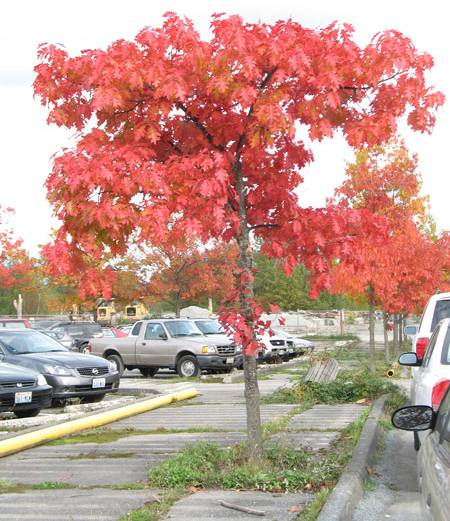Oaks for Utah
by Michael Kuhns, Extension Forestry Specialist
Oaks are the royalty of the tree world, and for good reason. Their wood is strong and durable, their wide, spreading crowns provide a stately elegance in the landscape, and they are tough and long lived. Though they are slower growing than many tree species, they are high quality. Utahans plant few oaks, however, because many choose faster growing species rather than high quality.
Oaks in general are intolerant of shade and tolerant of moderate to severe drought and heat. Some are quite tolerant of high soil pH and other adverse soil conditions common in Utah, though this varies widely. Crown forms vary from shrubby/clumpy to tall and wide-spreading to very narrow and upright. It should be easy to find an oak to fit almost any planting situation in Utah.
Utah’s native oaks all are more or less shrubby. The largest and most common native oak in Utah and throughout the Rocky Mountains is Gambel oak (Quercus gambelii), also known as scrub oak. It is found in all parts of Utah except north of about Ogden. This large shrub to medium-sized tree is native to fairly dry lower mountain slopes (USDA hardiness zones 4-8). It grows in clumps, forming dense, pure stands that present a fire hazard as fuel accumulates. It can be successfully managed or planted in cultivated landscapes.
Oak experts differ in their agreement about the other oak species native to Utah. There is fairly good agreement on shrub live oak (Quercus turbinella), which is found in southwestern Utah. The term “live oak” is commonly used in the U.S. when referring to evergreen oaks, and they are only found in warm locations. Shrub live oak, for example, is not found in the Cedar City area, but as you head south and go down in elevation it appears. This species is always shrubby. The leaves have sharp teeth or lobes that look somewhat like holly leaves.
There is less agreement on whether there is a separate species of shrubby oak growing amongst the Gambel oaks in southeastern Utah that is deciduous but with leaves that look more like shrub live oak’s leaves, usually referred to as Havard oak (Quercus havardii). Some also say that there is another evergreen oak in southwestern Utah growing amongst the shrub live oaks and the Gambel oaks, known for its undulating leaf margins and given the name wavyleaf oak (Quercus undulata), but others call it a possible hybrid between Gambel oak and shrub live oak. What seems certain is that there are numerous hybrids between all of the Utah oaks that grow together, with the hybrids varying in depth of lobes or teeth, whether they are evergreen or not, appearance of acorns, and other traits. For more information on oak hybrids in Utah, visit the Utah Native Plant Society’s website.

Planting of oaks in cultivated landscapes in Utah is very appropriate, since oaks are not weedy and many are appropriate for our climate. The list below includes many of the good species with cultivar names if available and USDA hardiness zones.
northern red oak (Quercus rubra) 'Aurea' (new leaves yellow, becoming green) zones 4-8
sawtooth oak (Quercus acutissima) 'Gobbler' (abundant acorns) zones 5-9
shingle or laurel oak (Quercus imbricaria) no cultivars available zones 4-8
Shumard oak (Quercus shumardii) no cultivars available zones 5-9
swamp white oak (Quercus bicolor) no cultivars available zones 3-8
turkey oak (Quercus cerris) 'Argenteo-variegata' (white blotches on leaf edges) zones 5-7
white oak (Quercus alba) See Q. robur above zones 3-9
| Species | Cultivars (characteristics) | Hardiness Zones |
|---|---|---|
| Bur or Mossycup Oak (Quercus macrocarpa) | No cultivars available | Zones 2-8 |
| Chinkapin Oak (Quercus muehlenbergii) | No cultivars available | Zones 4-7 |
| English oak (Quercus robur) | 'Atropurpurea' (purple leaves) 'Fastigiata' (upright, narrow) 'Pendula' (weeping form) Several hybrids with Q. alba available, generally with orange-red fall color |
Zones 4-8 |
| Northern Red Oak (Quercus rubra) | 'Aurea' (new leaves yellow, becoming green) | Zones 4-8 |
| Sawtooth Oak (Quercus acutissima) | 'Gobbler' (abundant acorns) | Zones 5-9 |
| Shingle or Laurel Oak (Quercus imbricaria) | No cultivars available | Zones 4-8 |
| Shumard oak (Quercus shumardii) | No cultivars available | Zones 5-9 |
| Swamp White Oak (Quercus bicolor) | No cultivars available | Zones 3-8 |
| Turkey Oak (Quercus cerris) | 'Argenteo-variegata' (white blotches on leaf edges) | Zones 5-7 |
| White Oak (Quercus alba) | See Q. robur above | Zones 3-9 |
Related Articles

